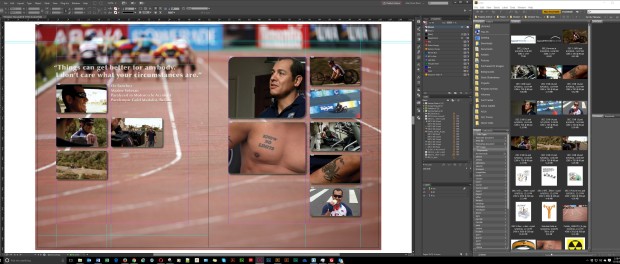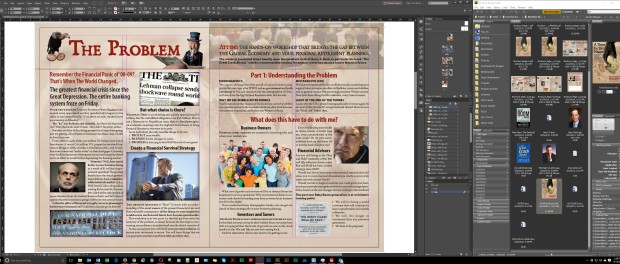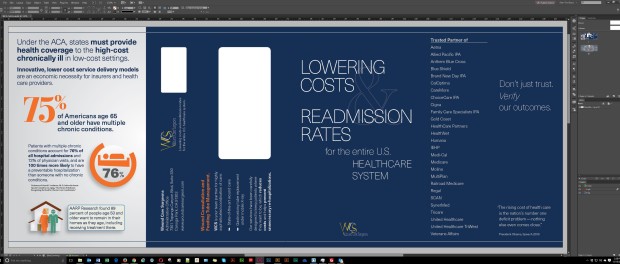An Ultrawide Monitor Could Transform Your Workflow
Pick your way past the gamer-oriented ads, and you find LG, HP, and Dell are all selling ultrawide monitors they say are for people who actually have to get work done. (Designers, animators, digital artists, video and motion graphics people are collectively “content creators” in current marketing-speak.) But are ultrawides a Thing, or just a gimmick? Can you actually get real work done on them? Is this really, as CreativeBloq claimed when the LG model first appeared, “a designer’s dream”?
Whether we’re doing print design, web development, motion graphics or video, many of us rely on multiple monitor setups. When I made the switch to dual monitors there was no going back. The extra screen real estate made working so much faster and easier that switching back to a single monitor was unthinkable. Or so it was at the time.
When LG, HP, Dell, and others came out with a new species of monitor sporting a seemingly absurd aspect ratio of 21:9, I wasn’t immediately impressed. Seriously? Did I really need a Cinemascope monitor (other than for watching some of the titles on Netflix)?
Ultrawide monitors sat on my “Ignore” pile until I actually saw a baby version in the flesh. This 29-inch, 8-bit display with a 2560×1080 resolution just kind of sat there in Best Buy, grinning at me. A quick bit of mental arithmetic told me the resolution was too low to be useful, but I realized that in a larger size, with a higher resolution, this could be an efficient canvas.
So I did what any self-respecting 21st Century gadget hound would do: I Googled. (Note to self: this may be the first known use of Google as an intransitive verb. Research.) And that is how I came to own a spanking-new 34-inch LG Ultrawide monitor.
The Basics
The specs are straightforward: all the manufacturers are offering 3440×1440 resolution at 34-inches diagonal (works out to about 105 ppi, to save you the math). Some are flat panels, some are curved and more expensive. Professional-grade models come factory-calibrated and are easily fine-tuned with a good color calibrator. In the case of the LG, a test certificate with the calibration data for my specific display was included in the box. Inputs include Thunderbolt (x2), DisplayPort and HDMI (x2 – more on that later). There’s a USB 3.0 hub built in.
A vertical resolution of 1440 pixels gives me enough to work with for most purposes. The 105 pixels per inch resolution, slightly improving on the 30” Apple Cinema display it replaced, is also plenty at desktop viewing distances.
There are several excellent reviews online, from the likes of Gizmag and Tom’s Hardware, of this model and others in its class, so I won’t be redundant. This article isn’t a hardware review. It’s an answer to my standard question, the one that stopped me buying an iPad for years: “What’s it useful for?”
Gimmick, or Not Gimmick?
Replacing a dual monitor setup with a single ultra-wide display makes for a slightly different way of working. What surprised me was how easily I made the transition and how much I gained in flexibility. What seemed at first glance to be a gimmicky way to sell more hardware turns out to be a thoroughly practical way to get more work done.
A typical dual monitor rig pairs two comparable monitors or, like mine, a large main display paired with a smaller one. My second monitor was a 1200×1920 (it was in portrait orientation) 24” Dell Ultrasharp. Adobe Bridge lived there almost permanently while I was working.
That second window was always 1200 pixels wide, with two fat bezels separating it from whatever was on the main display. It also had a slightly different resolution, and as the two displays aged it became more difficult to keep the colors perfectly in sync. Extending a single InDesign or Premiere window across both was possible, but not terribly practical or satisfying.
The new display is, of course, continuous. I didn’t realize how much bezels get in your way until I didn’t have them anymore. Bridge still lives in the right-hand third, roughly, of the screen. But it can be as narrow or as wide as I want, or I can overlay it completely, with, say, InDesign occupying the entire screen.
Real World Usefulness
Having all the real estate on a single continuous display is as transformative as moving from a single display to multiple monitors. (One caveat: you need a relatively modern GPU that is capable of supporting the full resolution at 60Hz. Check the specs of your video card.)
A typical working session for me might see a book or brochure spread in InDesign occupying most of the screen, with the rest taken up by Bridge, a manuscript open in Word, or even a browser window. Windows 10 users get the added benefit of an enhancement to the Windows “snap” feature: snap a window to one edge of the screen and adjust its size, then, when you snap a window to the other side it will automatically fill the remaining space.
One of the more frustrating things about working with a standard 16:9 or 16:10 monitor was that I could only see a very wide layout, such as a billboard or a landscape-oriented spread, in its entirety if I zoomed so far out that the details became tiny. On an Ultrawide monitor, that is much less of a problem.
Tiled InDesign windows benefit from the wider aspect ratio. Three documents can be tiled side by side without any of them feeling cramped.
Photoshop panoramas are notoriously awkward (at least around these parts) to work with on a regular monitor. The choice is between seeing the whole pano in miniature or working with a tiny part of it at a size that’s actually useful for retouching or editing. Behold, the joy of Cinemascope!
Video and motion graphics applications like Premiere Pro and After Effects get an obvious advantage from the wider format, without having to break out panels onto a separate monitor. Writers can keep a manuscript, reference materials, and a couple of full size browser windows open and visible, Excel and Numbers users can keep a ridiculous number of columns on-screen, and if you’re in a mood to be distracted you can devote a section of the screen to your favorite cat video playlist while keeping a normal monitor’s worth of content open to work on.
Choices
I purposely haven’t discussed other features, like splitting the display to show two different devices simultaneously, picture-by-picture style, because different manufacturers’ models have their own feature sets. There are ultrawide monitors on offer from Dell, LG, Samsung, Acer, Asus, and others, with more coming on the market every month. You will have to make your own list of what capabilities are most important to you, and choose from there.
The bottom line is that this new breed of monitor isn’t the sales gimmick it may appear to be. This is a great way to work and a great way to grab back some of your real-world desk space. If you decide to take the plunge, no matter which brand you choose, I predict you’ll find the ultrawide format more practical and enjoyable to work with than you expect.









Great write-up, Alan! But there is probably a significant difference between the 2560×1080 version and the 3440×1440 resolution. I’m using a relatively inexpensive AOC with only 1080 max vertical resolution and the resolution is “chunky” for sure. Definitely distracting when you’re used to higher res monitors (like Retina or thunderbold display)
Thanks for the kind words! There is indeed a significant difference between the 2560×1080 and 3440×1440 resolutions in terms of efficiency. There’s a good reason for this. UI elements, such as the panels in Bridge, InDesign, Photoshop or Premiere, have fixed pixel count. The lower the total screen resolution, the higher the proportion taken up by UI. Work space increases exponentially as resolution goes up, while UI remains fixed. :)
Great article! Thank you, i’ve been playing with the idea of going single wide monitor with either the Dell 34 or LG 34 curved models. At the moment I am running 2 x 23″ Dell Ultrasharpes (2012), as great as they are, the bezel is getting annoying now approx 10mm on each monitor.
This article has helped me confirm a move to single 34 wide, when I can afford it that is :(
You’re welcome! I didn’t go with a curved screen because I’m designing for flat surfaces. The theory is, I suppose, that people will sit so close to the screen that they need the curve. I don’t. Besides, the flat-screen models are around $400 cheaper. :)
Interesting side note: In Adobe’s feature video on the cutting of the Coen Brothers’ “Hail Caesar” using Premiere Pro, you’ll see a number of LG Ultrawides in use.
Hello,
Does anybody know if one can view e.g. 4 pdf pages besides eachother on an ultr-wide monitor? Which PDF reader can do that? Is it feasible or not at all?